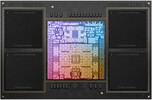Apple M2 Max vs Qualcomm Snapdragon X Elite X1E-84-100 vs Qualcomm Snapdragon X Plus X1P-64-100
Apple M2 Max
► remove from comparison
The Apple M2 Max is a System on a Chip (SoC) from Apple that is found in the early 2023 MacBook Pro 14 and 16-inch models. It offers all 12 CPU cores available in the chip divided in eight performance cores (P-cores) and four power-efficiency cores (E-cores). The E-cores clock with up to 3.4 GHz, the P-Cores up to 3.7 GHz (mostly 3.3 GHz in multi-threaded workloads and 3.4 GHz in single threaded).
The big cores (codename Avalanche) offer 192 KB instruction cache, 128 KB data cache, and 36 MB shared L2 cache (up from 24 MB in the M1 Pro). The four efficiency cores (codename Blizzard) are a lot smaller and offer only 128 KB instruction cache, 64 KB data cache, and 4 MB shared cache. CPU and GPU can both use the 49 MB SLC (System Level Cache).
The unified memory (32, 64, or 96 GB LPDDR5-6400) next to the chip is connected by a 512 Bit memory controller (400 GB/s bandwidth) and can be used by the GPU and CPU.
The CPU performance should be quite similar to the M2 Pro as only the higher memory bandwidth and bigger L3 cache could make a difference for some workloads.
The integrated graphics card in the M1 Max offers a 30-core GPU or a GPU with all 38 cores.
Furthermore, the SoC integrates a fast 16 core neural engine (faster than M1 Max), a secure enclave (e.g., for encryption), a unified memory architecture, Thunderbolt 4 controller, an ISP, and media de- and encoders (including ProRes).
The M2 Max is manufactured in 5 nm at TSMC (second generation) and integrates 40 billion transistors. The power consumption of the CPU part is up to 36 Watt according to powermetrics. When fully loading the CPU and GPU cores, the chip uses up to 89 Watt and the CPU part is limited to 25 Watt.
Qualcomm Snapdragon X Elite X1E-84-100
► remove from comparison
The Snapdragon X Elite X1E-84-100 is a pretty fast ARM architecture processor (SoC) for use in Windows laptops. The X1E-84-100 is the fastest member of the Snapdragon X series, as of May 2024; as such, it has 12 Oryon CPU cores (3 clusters of equally powerful cores; 12 threads) running at up to 4.2 GHz, along with the 4.6 TFLOPS Adreno X1-85 GPU, the 45 TOPS Hexagon NPU and an impressively fast LPDDR5x-8448 memory controller.
Two slower Snapdragon X Elite flavors exist, known as the X1E-80-100 and X1E-78-100. In the meantime, the X1E-00-1DE is a special version of the X1E-84-100 aimed at system makers and software developers that has just slightly higher single-core and dual-core Boost clock speed of 4.3 GHz but otherwise the same CPU/GPU/NPU configuration.
Architecture and Features
Qualcomm Oryon cores are in part based on Nuvia IP; they most likely make use of the ARM v8.7 microarchitecture. Much like modern AMD and Intel processors, the Snapdragon chip is compatible with USB 4 and thus with Thunderbolt 4 but it remains to be seen if the X Elite is compatible with GeForce or Radeon discrete graphics cards.
The Qualcomm SoC is believed to have at least 12 PCIe 4 and 4 PCIe 3 lanes for connecting various kinds of devices. NVMe SSDs are supported with a throughput of up to 7.9 GB/s; furthermore, most laptops built around the chip are expected to have 16 GB of LPDDR5X-8448 RAM. There is also a 45 TOPS NPU for accelerating AI workloads.
Performance
When all of the 12 cores are under load, they run at up to 3.8 GHz. The 4.2 GHz clock speed is only achievable under single-thread or dual-thread loads.
Taking the difference in clock speeds into consideration, its multi-thread performance should be around 12% higher than the of the X Elite X1E-78-100 for AMD Ryzen 7 8845HS-like performance in most real-world tasks. We'll make sure to update this section once we get our hands on a laptop powered by the X1E-84-100.
Like any other Windows on ARM platform, the Snapdragon X chip works best with applications and games compiled specifically for ARM processors. If making use of the built-in x86 to ARM emulation mode, a performance penalty of about 20% is to be expected.
Graphics
The integrated X1-85 GPU is DirectX 12-enabled but not DirectX 12 Ultimate-enabled, despite featuring VRS and ray tracing support. The 4.6 TFLOPS of performance that it supposedly delivers represent a half of what the slowest current-generation professional Nvidia Ada graphics card for laptops, the RTX 500 Ada, is capable of.
Its gaming performance is set to be just slightly better than that of the Radeon 780M. That should be sufficient for about 30 fps in Baldur's Gate 3, a triple-A title released in 2023, at 1080p / Low. Older games will run just fine with most settings set to Medium.
The Qualcomm iGPU will let you use up to 3 UHD 2160p monitors simultaneously. 2160p120 integrated displays are supported, as are the popular AV1, HEVC and AVC video codecs (both decoding and encoding). The hardware does not support the VVC codec; that feature remains a Lunar Lake exclusive for now.
Power consumption
As the most powerful Snapdragon X Elite chip, the X1E-84-100 can eat up to 80 watts depending on the system. This will differ from one laptop to another, with most designs expected to target the 40 W sweet spot.
The SoC is built with a 4 nm TSMC process for decent, as of H1 2024, energy efficiency.
Qualcomm Snapdragon X Plus X1P-64-100
► remove from comparison
The Snapdragon X Plus X1P-64-100 is a moderately fast ARM architecture processor (SoC) for use in Windows laptops that debuted in April 2024. The X1P-64-100 has 10 Oryon CPU cores (10 threads) running at no more than 3.4 GHz. Other key features include the 3.8 TFLOPS Adreno GPU, the 45 TOPS Hexagon NPU and an impressively fast LPDDR5x-8448 memory controller.
The chip's smarter X Elite series brothers including first and foremost the Snapdragon X Elite X1E-84-100 are thought to be based on the same die with the same NPU but with more CPU cores enabled, a faster GPU (possibly due to faster clock speeds), higher CPU clock speeds and possibly higher power targets as well.
Architecture and Features
Qualcomm Oryon cores are in part based on Nuvia IP; they most likely make use of the ARM v8.7 microarchitecture. Much like modern AMD and Intel processors, the Snapdragon chip is compatible with USB 4 and thus with Thunderbolt 4 but it remains to be seen if it is is compatible with GeForce or Radeon discrete graphics cards.
The Qualcomm SoC is said to have 12 PCIe 4 and 4 PCIe 3 lanes for connecting various kinds of devices. NVMe SSDs are supported with a throughput of up to 7.9 GB/s; furthermore, most laptops built around the chip are expected to have 16 GB of LPDDR5X-8448 RAM. There is also a 45 TOPS NPU for accelerating AI workloads.
Performance
Its multi-thread performance is very close to that of the Intel Core i7-13700H and the 9-core Apple M4, meaning this is a pretty fast CPU that's good for most tasks one could possibly throw at it in 2024.
Like any other Windows on ARM platform, the Snapdragon X chip works best with applications and games compiled specifically for ARM processors. If making use of the built-in x86 to ARM emulation mode, a performance penalty of about 20% is to be expected.
Graphics
The 3.8 TFLOPS Adreno iGPU is DirectX 12-enabled but not DirectX 12 Ultimate-enabled, despite featuring VRS and ray tracing support. The 3.8 TFLOPS of performance that it supposedly delivers pale in comparison to the slowest current-generation professional Nvidia Ada graphics card for laptops, the RTX 500 Ada, that delivers up to 9.2 TFLOPS.
Its gaming performance is rather underwhelming; while slightly faster than the aging Iris Xe (96 EUs), the Adreno is not fast enough to outpace the Radeon 780M meaning there is little point in comparing it with full-fat discrete graphics cards. Baldur's Gate 3, a triple-A title released in 2023, is pretty much unplayable at 1080p / Low. GTA V, a game that saw the light of day in 2015, is playable at 1080p / High.
The Qualcomm iGPU will let you use up to 3 UHD 2160p monitors simultaneously. 2160p120 integrated displays are supported, as are the popular AV1, HEVC and AVC video codecs (both decoding and encoding). The hardware does not support the VVC codec; that feature remains a Lunar Lake exclusive for now.
Power consumption
The X1P-64-100 is most likely going to be less power-hungry than its more powerful X Elite brothers. Expect to see anything between 10 W and 35 W under long-term workloads because that's what Ryzen U chips normally consume.
The SoC is built with a 4 nm TSMC process for decent, as of H1 2024, energy efficiency.
| Model | Apple M2 Max | Qualcomm Snapdragon X Elite X1E-84-100 | Qualcomm Snapdragon X Plus X1P-64-100 | ||||||||||||||||||||||||||||||||||||||||||||||||||||||||
| Series | Apple Apple M2 | Qualcomm Snapdragon X | Qualcomm Snapdragon X | ||||||||||||||||||||||||||||||||||||||||||||||||||||||||
| Series: Snapdragon X Oryon |
|
|
| ||||||||||||||||||||||||||||||||||||||||||||||||||||||||
| Clock | 2424 - 3696 MHz | <=4200 MHz | <=3400 MHz | ||||||||||||||||||||||||||||||||||||||||||||||||||||||||
| L1 Cache | 3.3 MB | ||||||||||||||||||||||||||||||||||||||||||||||||||||||||||
| L2 Cache | 36 MB | ||||||||||||||||||||||||||||||||||||||||||||||||||||||||||
| L3 Cache | 48 MB | ||||||||||||||||||||||||||||||||||||||||||||||||||||||||||
| Cores / Threads | 12 / 12 | 12 / 12 12 x 4.2 GHz Qualcomm Oryon | 10 / 10 10 x 3.4 GHz Qualcomm Oryon | ||||||||||||||||||||||||||||||||||||||||||||||||||||||||
| TDP | 79 Watt | ||||||||||||||||||||||||||||||||||||||||||||||||||||||||||
| Transistors | 67000 Million | ||||||||||||||||||||||||||||||||||||||||||||||||||||||||||
| Technology | 5 nm | 4 nm | 4 nm | ||||||||||||||||||||||||||||||||||||||||||||||||||||||||
| Features | ARMv8 Instruction Set | ||||||||||||||||||||||||||||||||||||||||||||||||||||||||||
| iGPU | Apple M2 Max 38-Core GPU | Qualcomm Snapdragon X Adreno X1-85 GPU | Qualcomm Snapdragon X Adreno 3.8 TFLOPS GPU | ||||||||||||||||||||||||||||||||||||||||||||||||||||||||
| Architecture | ARM | ARM | ARM | ||||||||||||||||||||||||||||||||||||||||||||||||||||||||
| Announced | |||||||||||||||||||||||||||||||||||||||||||||||||||||||||||
| Codename | Oryon | Oryon | |||||||||||||||||||||||||||||||||||||||||||||||||||||||||
| TDP Turbo PL2 | 80 Watt | ||||||||||||||||||||||||||||||||||||||||||||||||||||||||||
| Manufacturer | www.qualcomm.com | www.qualcomm.com |


 Deutsch
Deutsch English
English Español
Español Français
Français Italiano
Italiano Nederlands
Nederlands Polski
Polski Português
Português Русский
Русский Türkçe
Türkçe Svenska
Svenska Chinese
Chinese Magyar
Magyar
